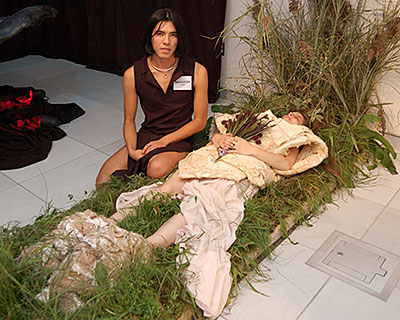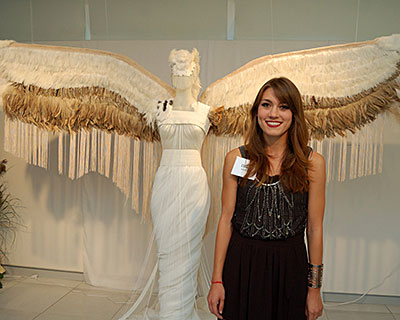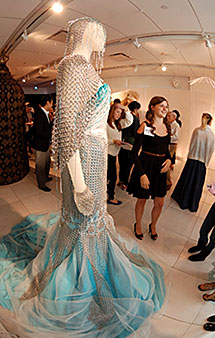Mushrooms, wings, experimental designs highlight student fiber arts exhibit
By Ted Boscia


Sophomore fashion design major Brandon Wen's edgy piece in the seventh Barbara L. Kuhlman Foundation's Fiber Arts and Wearable Arts Exhibition, on display in the Jill Stuart Gallery in the Human Ecology Building, was inspired by nature, film, art and fashion. But to pull off his creative vision, he needed help from a Cornell mycologist.
Wen, with advice from Kathie Hodge, associate professor of plant pathology and plant-microbe biology, fashioned a sarcophagal garment from a mushroom-based fabric custom-made by Ecovative Design near Albany, N.Y. Hodge helped Wen research the suede-like fabric -- a blend of mushroom composites and agricultural byproducts -- and other alternatives that could evoke the exhibition's "Rapture" theme. For the show's Sept. 10 opening, a live model donned Wen's earth-stained gown and fungal mycelium jacket and lay in a bed of wild grasses and soil.
"I interpreted 'Rapture' as the concept of transforming from one state of being to another -- not so much in a spiritual sense but in a more natural idea of returning to the earth after we die," Wen said.
Wen and six other Fiber Science & Apparel Design (FSAD) students in the College of Human Ecology experimented with unique materials and forms for the annual exhibition. They began last fall by preparing detailed funding proposals for the Kuhlman Foundation, a nonprofit dedicated to fiber and wearable arts. With their scholarship awards, over the spring and summer students sourced their materials and devoted hundreds of hours to crafting their fanciful creations.

"We spent a year on these pieces," said Wen. "It's a rare opportunity to have the time and resources you otherwise wouldn't have."
Also among the highlights at the exhibit: a floor-to-ceiling sanctuary, curtained in embroidered velvet and topped with an original stained glass panel fabricated by Grace Choi '14; an ethereal tribal gown and headpiece affixed with two 6-foot-long wings made from hundreds of rooster and ostrich feathers by Dale Kinney '14; and a dress with a meticulously beaded bodice and draped in hand-crafted steel and aluminum chain mail by Madeline Miles '14.
Miles was inspired in part by an exhibit on armor she saw at the Metropolitan Museum of Art and bought 30 pounds of metal rings online to try out different techniques and patterns for linking the chain mail. While in New York City for an internship last summer, she visited craft stores to track down the right materials and then taught herself traditional hand-beading.
"I would be beading all day for three days a week, and think I had arthritis by the end," Miles joked. "I really enjoyed the trial and error of the design process and being free to experiment with different ideas."
The students were guided throughout the process by exhibition directors FSAD associate professor Van Dyk Lewis and senior lecturer Anita Racine.
"For a full year, we are immersed in the process of encouraging the Kuhlman scholars to reach their highest artistic potential through design research and experimentation," Racine said. "Engagement in the Kuhlman program is one of the most rewarding aspects of teaching at Cornell."
The Kuhlman Exhibition is on display until Nov. 15.
Ted Boscia is assistant director of communications for the College of Human Ecology.
Media Contact
Get Cornell news delivered right to your inbox.
Subscribe